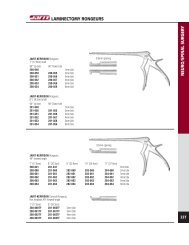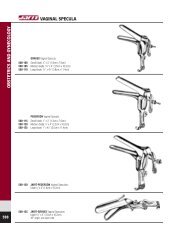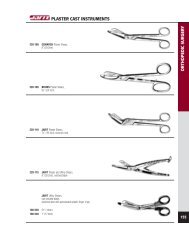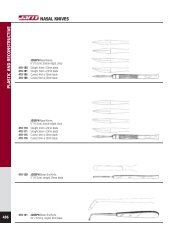AquaShape LipoCollector™ Instructions for use
AquaShape LipoCollector™ Instructions for use
AquaShape LipoCollector™ Instructions for use
You also want an ePaper? Increase the reach of your titles
YUMPU automatically turns print PDFs into web optimized ePapers that Google loves.
Human Med AG<br />
<strong>Instructions</strong> <strong>for</strong> <strong>use</strong> and processing of the LipoCollector TM<br />
Careful operation increases the quality of the aspirate<br />
Page:<br />
Vers./Date:<br />
17 of 20<br />
1 / 15.07.2008<br />
The vacuum should only be as high as necessary to achieve a good suction result. The<br />
recommendation is max. -0.5 bar. On one hand this reduces excessive suction of the aspirate<br />
above and through the filter which can also ca<strong>use</strong> blockages. On the other hand the mechanical<br />
load on the lipocytes is reduced, which should also be advantageous <strong>for</strong> the quality of the<br />
lipocyte concentrate.<br />
To ensure trouble-free collection of the fat component of the aspirate it is advantageous to<br />
operate with steady cannula movements. The surgeon should 'allow the water to do the work'<br />
and not extract the fat by dissection using <strong>for</strong>ce on the suction opening of the cannula. The fat<br />
should rather be 'rinsed free' so that connective tissue components can be avoided in the aspirate<br />
as far as possible.<br />
It is recommended to work with a 3.5 mm cannula or 3.8 mm at the most so that loosened fat<br />
particles or cell islets remain as small as possible.<br />
The water pressure should generally be Range 2 or 3 (body-jet® and <strong>AquaShape</strong> ® mobile).<br />
Collected quantity / liquid fraction of the aspirate<br />
Filtration of the aspirate with the LipoCollector TM takes place – intentionally – almost<br />
exclusively using buoyancy and gravity, as the suction of the system during liposuction is<br />
directed through the bypass hole on the container insert adjacent to the previously collected<br />
aspirate. This means the lipocytes that have been suctioned off are treated as gently as possible.<br />
NOTE: Pay attention during liposuction to the level of liquid in the container. If the liquid/fat<br />
concentrate level in the container has reached the height of the bypass tube in the container, it<br />
can overflow, causing loss of subsequent incoming aspirate.<br />
The portion of liquid remaining in the aspirate after completely passing through is about 20%-<br />
25%, which is also necessary to be able to re-inject the fat later through thin cannulae if<br />
necessary. The means that centrifugation can generally be omitted.<br />
The quantity of collected fat-liquid mixture can be approximated using the scale on the side of<br />
the container. Subtract 200 ml from the value read from the scale (<strong>for</strong> the container volume<br />
beneath the filter unit and the volume of the insert). To calculate the quantity of solid<br />
components, a liquid fraction of about 20%-25% must be subtracted.<br />
Example calculation: Drain volume, read from container scale: 800 ml<br />
- 200 ml void volume<br />
= 600 ml fat-liquid mixture<br />
- 25% liquid fraction<br />
= approx. 450 ml fraction of solid components ('pure' fat)<br />
Removal of fat from the container<br />
Be<strong>for</strong>e removing fat from the LipoCollector TM the liquid fraction in the aspirate should be<br />
reduced by allowing the suction pump to run <strong>for</strong> a short time (approx. 2 minutes) after<br />
completion of the liposuction. The flow of the liquid can be easily seen through the transparent<br />
container.<br />
The filtered aspirate can also be withdrawn using a cannula while keeping the lid closed to avoid<br />
further contact with air as much as possible. To do this, the reducer is simply removed from the<br />
lid and the opening <strong>use</strong>d <strong>for</strong> removal of the aspirate.







